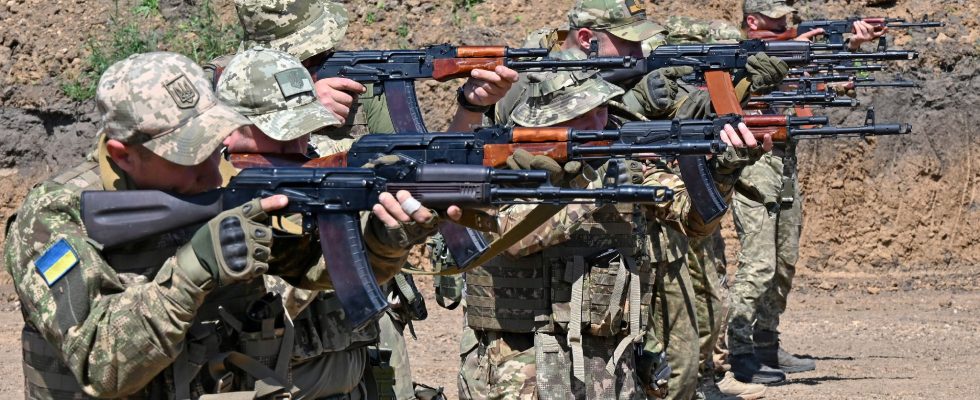Spray-painted on a building in Lugansk, in the Donbass, is a ribbon in the yellow color of Ukraine: simple graffiti, but a real sign of defiance to the Russian forces which control the city. In Yalta, Crimea, the same symbol appears here and there, on the trees, railings and low walls of the seaside resort located on the shores of the Black Sea. In these two cities, nearly 1,000 kilometers apart, members of the Ukrainian resistance movement Yellow Ribbon, founded two months after the start of the Russian invasion, launched new actions on the night of June 10. Present in the territories occupied by the Russians since 2022, as in 2014, the organization has a clear objective: to fight, in a non-violent way, against the occupiers.
In the galaxy of resistance movements born after the February 24 invasion of Ukraine, others have chosen arms. On June 11, partisans demanded the elimination of a group of Russian soldiers who occupied a house in the village of Chkalove, not far from Melitopol, in the south of the country. “The enemy cannot feel safe in the temporarily occupied territories of the Zaporizhia region. It does not matter whether he is at the front or in the rear”, proclaims the National Resistance Center (NRC), which depends on the Ukrainian army, and took over the operation. On the same day, a railway bridge was reportedly targeted further north in the village of Yakymivka, while a bomb blew up a railway track in Crimea. “The action of the partisans is essential, emphasizes General Nicolas Richoux, former commander of the 7th Armored Brigade. By being active in the rear, they can destroy enemy lines of communication and disrupt its logistics.” A precious asset, at a time when kyiv has launched its counter-offensive, to reconquer its lost territories.
“Yesterday betrayal, today panic”
The first actions began less than a week after the start of the invasion. Considered a “traitor”, the pro-Russian mayor of the city of Kreminna, Volodymyr Struk, was found dead on March 2, 2022, of a bullet to the heart, after being kidnapped the day before by men in fatigues. Since then, in the occupied territories, a long list of local officials have followed him to the grave. Thus the Russian director in charge of youth in the city of Kherson, Dmitro Savluchenko, killed in his car on June 24, 2022; the deputy head of the occupation administration of Nova Kakhovka, Vitaly Gura, shot on August 6, 2022 in the street; or more recently the Melitopol police chief, Oleksandr Mishchenko, who died in an explosion at the entrance to his home. “The path of each collaborator is predictable: yesterday betrayal, today panic, tomorrow massacre”, reacted on Telegram the mayor in exile of Melitopol, Ivan Fedorov, following the homicide.
“We only know a part of what is happening, insofar as it is generally about actions that are not very attributable and not very attributed, notes Mathieu Boulègue, Chatham House associate researcher. sabotages and targeted assassinations, the partisans are also active in intelligence, and carry out reconnaissance operations in order to recover information where the Ukrainian army is not able to go. On June 13, the NRC called on all residents of the occupied territories “to help the partisans and join the resistance”. “Thanks to the activities of the Ukrainian maquis, which transmits information about the enemy, the defense forces manage to eliminate the invaders. Therefore, your activity and the activity of those who heroically resist the enemy occupation bring us closer to the victory”, writes the organization on its site, which also offers practical instructions for “fighting the enemy effectively” and “in safety”.
Dilution of Russian forces
Among the most active groups is the Atesh movement (fire, in Ukrainian), whose members claimed responsibility for the car bomb attack in early May that seriously injured Zakhar Prilepin, a prominent pro-Kremlin propagandist, in a village in the region. of Nizhny Novgorod in Russia. Among other feats of arms, this group founded in September 2022 by Crimean Tatars, Ukrainians and Russians, claimed the elimination of a Russian unit on patrol in the Kherson region last April, or that of two Russian officers in Crimea, late January. “Maintaining a fight of insecurity in the occupied territories forces the Russians to dilute their forces by leaving more men behind to ensure security, points out General Richoux. This can quickly represent thousands of men and that is a real handicap, which the Germans knew well during the Second World War.
If at the beginning of May, the Russian Federal Security Service (FSB) – which was able to perfect its brutal methods of counter-insurgency in the 1990s in Chechnya – announced the arrest in Crimea of seven individuals armed with “explosive devices”, Moscow was nevertheless obliged, according to the Ukrainian authorities, to reinforce its occupation police later in the month with forces from the Rosgvardia, the Russian national guard.
To improve the tracking of partisans, the occupation authorities are said to have also introduced a system of “passes” in the Zaporijia region, in addition to increasing the number of cameras at the beginning of June responsible for monitoring towns and cities. Strategic axes. “The multiplication of attacks also aims to create a feeling of fear among the Russian occupying forces, points out General Dominique Trinquand, former head of the French mission to the UN. The objective is to increase the cost of holding these territories.” A point on which the NRC could not be clearer on its site, summarizing its motto in these terms: “Together, we will transform the lives of the occupants into hell.”
